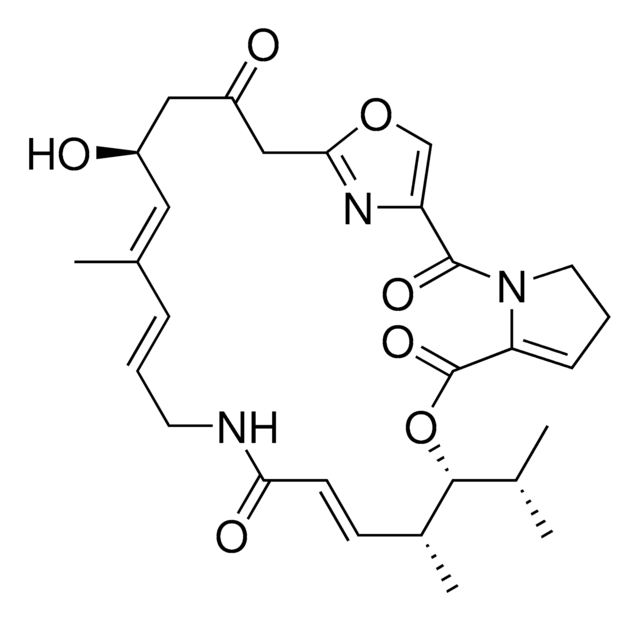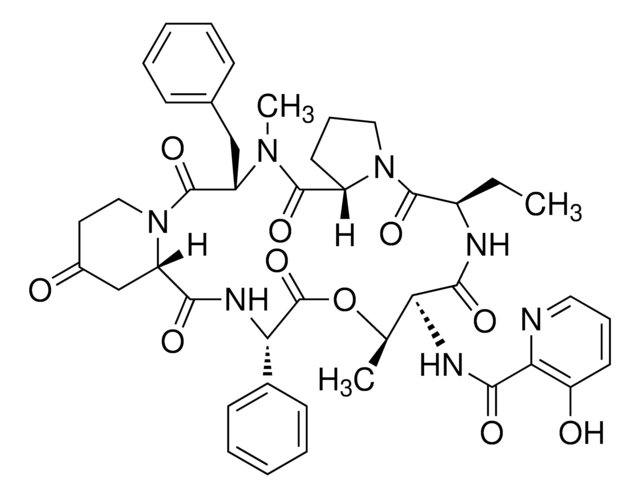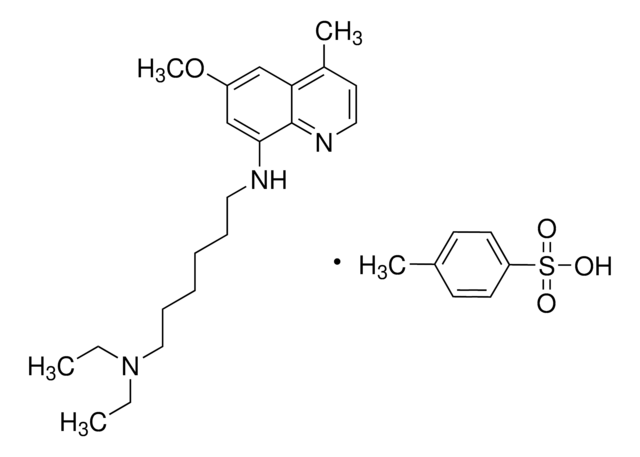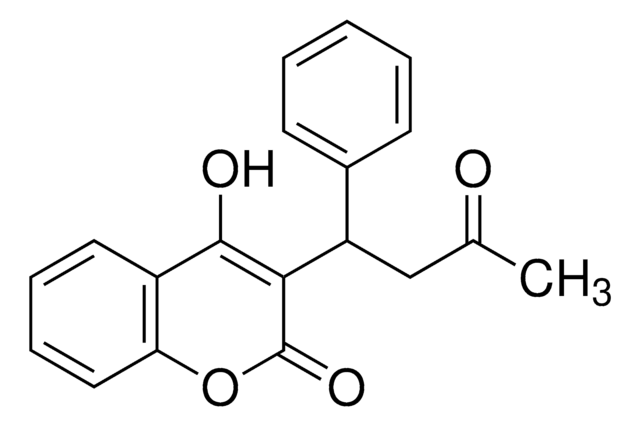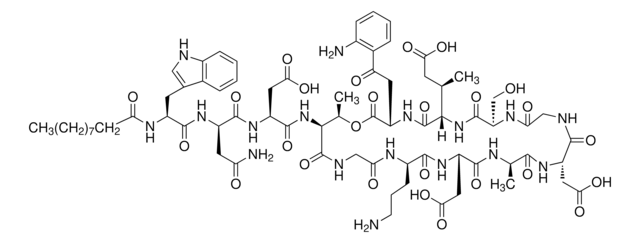推荐产品
品質等級
化驗
≥98% (Assay)
形狀
powder
顏色
white to faint yellow
抗生素活性譜
Gram-positive bacteria
作用方式
protein synthesis | inhibits
儲存溫度
2-8°C
SMILES 字串
CN(C)C1=CC=C(C[C@@H](C(N2CCC(C[C@H]2C(N[C@@H](C3=CC=CC=C3)C(O[C@H](C)[C@H](NC(C4=NC=CC=C4O)=O)C5=O)=O)=O)=O)=O)N(C)C([C@H]6N(C([C@@H](N5)CC)=O)CCC6)=O)C=C1.O=C(N7C(C(O[C@H](C(C)C)[C@H](C)/C=C/C(NC/C=C/C(C)=C/[C@@H](O)CC(C8)=O)=O)=O)=CCC7)C9=COC8=N9
InChI
1S/C45H54N8O10.C28H35N3O7/c1-6-31-42(59)52-22-11-14-32(52)43(60)51(5)34(24-27-16-18-29(19-17-27)50(3)4)44(61)53-23-20-30(54)25-33(53)39(56)49-37(28-12-8-7-9-13-28)45(62)63-26(2)36(40(57)47-31)48-41(58)38-35(55)15-10-21-46-38;1-17(2)26-19(4)9-10-24(34)29-1
一般說明
Pristinamycin is a broad-spectrum streptogramin antibiotic composed of two components, pristinamycin IA (a macrolide) and pristinamycin IIA (a streptogramin A-type antibiotic). These components exhibit strong synergistic antibacterial activity against a wide range of Gram-positive and some Gram-negative bacteria, including resistant strains. Pristinamycin is derived from Streptomyces species and can also be produced by the genus Xenorhabdus. It is commonly used in cell biology applications to prevent the growth of bacterial contaminants and ensure the purity of cell lines. Each component of pristinamycin inhibits protein elongation by binding to the 50S ribosomal subunit, making pristinamycin a bacteriostatic antibiotic.
應用
Pristinamycin has been used:
- in cloning and sequencing of genes involved in the biosynthesis of the depsipeptide antibiotics pristinamycins I (PI) produced by Streptomyces pristinaespiralis
- in a study on inducible gene expression system in mycobacteria
生化/生理作用
Mode of Action: Involves two mechanisms: protein synthesis and cell wall synthesis. Pristinamycin effectively inhibits bacterial growth and exhibits bacteriostatic or bactericidal effects against susceptible bacteria.
Activity spectrum: Pristinamycin shows anti-bacterial activity against Gram-positive bacteria like Staphylococcus spp. and Streptococcus spp. Pristinamycin displays antimicrobial activity against macrolide-resistant Mycoplasma genitalium infection.
- Inhibition of protein synthesis: Pristinamycin binds to the 50S ribosomal subunit in bacterial cells, thereby inhibiting the formation of peptide bonds during protein synthesis. This disrupts the translation process and prevents the production of essential proteins necessary for bacterial growth and survival.
- Interference with cell wall synthesis: Pristinamycin also interferes with the synthesis of bacterial cell walls. It inhibits the transpeptidation step of peptidoglycan biosynthesis, which is essential for the cross-linking of cell wall components. This leads to the weakening of the bacterial cell wall and eventual cell lysis
Activity spectrum: Pristinamycin shows anti-bacterial activity against Gram-positive bacteria like Staphylococcus spp. and Streptococcus spp. Pristinamycin displays antimicrobial activity against macrolide-resistant Mycoplasma genitalium infection.
特點和優勢
- Broad-spectrum activity: Pristinamycin is effective against a wide range of bacteria, including both Gram-positive and Gram-negative bacteria, as well as resistant strains.
- Synergistic effect: The two components of pristinamycin work together to produce a synergistic effect, meaning that they are more effective together than they are individually.
- Versatility: Pristinamycin can be used in Cell Biology and Biochemical applications
其他說明
For additional information on our range of Biochemicals, please complete this form.
儲存類別代碼
11 - Combustible Solids
水污染物質分類(WGK)
WGK 3
閃點(°F)
Not applicable
閃點(°C)
Not applicable
Jönike Dreyer et al.
Frontiers in microbiology, 9, 3177-3177 (2019-01-09)
The genus Xenorhabdus of the family Enterobacteriaceae, are mutualistically associated with entomopathogenic nematodes of the genus Steinernema. Although most of the associations are species-specific, a specific Xenorhabdus sp. may infect more than one Steinernema sp. During the Xenorhabdus-Steinernema life cycle
我们的科学家团队拥有各种研究领域经验,包括生命科学、材料科学、化学合成、色谱、分析及许多其他领域.
联系技术服务部门